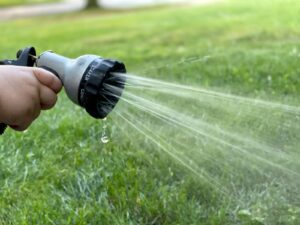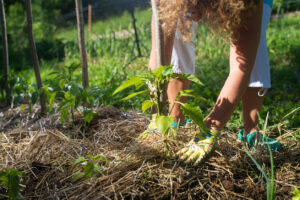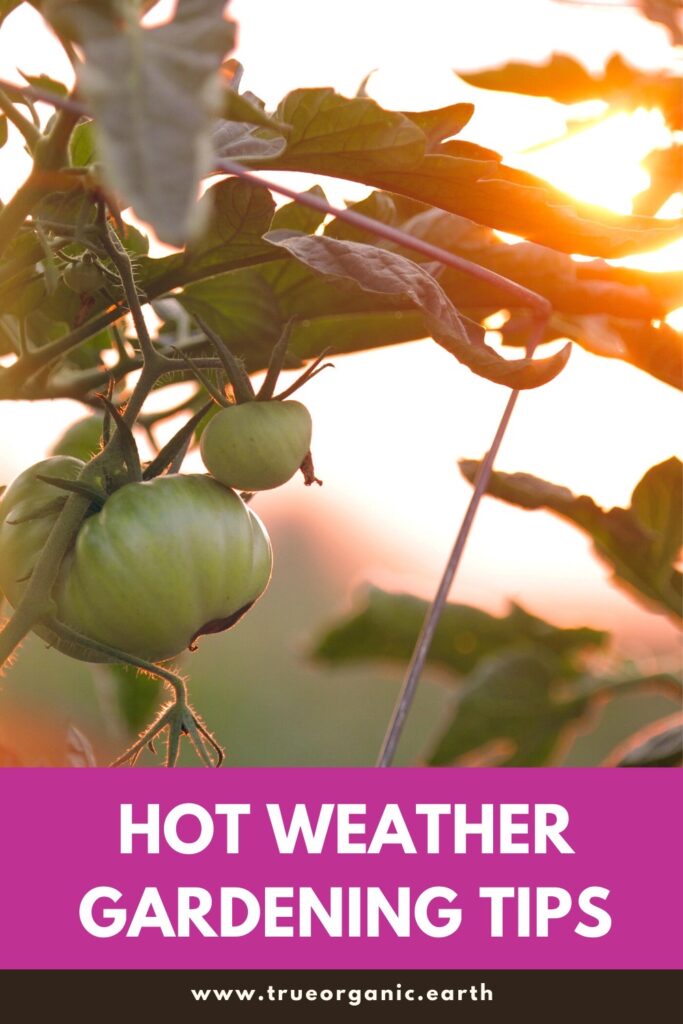July 28, 2022
True Organic Hot Weather Gardening Tips
Hot Weather Gardening Tips
Summer is blazing again, and heat waves are sweeping through every corner of the country. Is your garden ready to weather the summer heat?
Wise Watering
 Did you know that the average American household uses about 300 gallons of water per day, and 30-60% of that water goes to outdoor uses? That’s about 8 billion gallons per day across the United States used for outdoor activities, like watering the garden.
Did you know that the average American household uses about 300 gallons of water per day, and 30-60% of that water goes to outdoor uses? That’s about 8 billion gallons per day across the United States used for outdoor activities, like watering the garden.
Especially in the Western U.S., summer (and sometimes even years-long) drought conditions are now a seasonal part of life. With local water-use guidelines, too, it’s a good idea to learn the best ways to keep your garden hydrated as efficiently as possible.
- Water your plants early in the morning or the evening, when the temperature isn’t too high.
- Water at the roots! Water right at the base of a plant, close to the soil, so that the soil soaks up and retains as much water as possible.
- Avoid watering on foliage. If water droplets sit on plants’ leaves as the hot sun beats down, the sun’s rays can get magnified and burn foliage.
- If you have a small garden or plants in various locations, water by hand. This will reduce water waste and get the water closer to roots.
- If you use sprinklers, try a system that waters close to the ground (rather than spraying high in the air) to minimize water waste and in-air evaporation.
- Or replace your sprinklers with a drip irrigation system! This works especially well in raised bed gardens.
What about tomatoes? Tomato growers are eager to understand just how much water is needed (vs. too much) for tomatoes in the summer. While the answer is subjective, most tomatoes need 1-2 inches of water every week, whether from rainfall or hand-watering. On very hot days, it’s not a bad idea to water tomatoes in the morning and the evening.
Read much more about watering tomatoes from our R&D Agronomist, Margaret McCoy, PhD!
Keep Plants Cool
Covering soil or providing plants with some shade is a great way to protect plants during hot, sunny days. Not only does shade help prevent soil and roots from drying out too severely, it also protects foliage from burns.
You can use mulch, shade cloth, shade from trees, or even your patio shade to protect plants.
- Mulching around your plants helps keep soil cool and prevents overly quick evaporation. For the most cost-effective mulch, use straw or compost to cover soil just a few inches around your plant’s stems.
- Use a shade cloth over delicate plants like lettuces and other leafy veggies, fruit trees, berries, and perennials. Leave some room for air circulation so your plants aren’t smothered! You can find shade cloth at any hardware or garden stores in various shade percentages.
- Move container plants and hanging baskets to shadier spots during heat waves.
- Watch out, particularly for your hanging containers — their soil dries out faster than any other container. Move hanging plants to a shaded patio on the hottest days, if possible.

Go Easy on Your Plants
When temperatures exceed 80-85ºF, your plants are working hard just to keep themselves alive.
Avoid any activity that might stress them even more. You’ll want to wait until the heat has passed before you:
- Prune
- Transplant
- Fertilize
Yep, feeding your plants when they’re stressed from heat is a no-go! It seems like a helpful move to give your plants a nutrient boost when they are stressed, but they can’t handle the supplemental nutrients when they are under duress.
And of course, don’t plant anything new until the weather is more temperate. Seedlings won’t stand the heat.
Choose Your Plants Wisely
Drought-resistant and native are easier for you to care for and can help save water. For example, if you live in a low-rainfall area, avoid trying to grow plants that need a ton of moisture. Populating your garden with as many native, low-water plants as you can also helps support naturally healthy ecosystems and soil.
Choose some drought-resistant perennials for your garden like:
- Yarrow
- Sunflower
- Lavender
- Goldenrod
- Thyme
- Yucca
Look into what types of native, low-water plants are right for your Climate Zone by seeking out advice from your local Land-Grant educational institution or horticulture extension of a local university. You can also visit your friendly local nursery for on-the-spot advice. (And while you’re there, why not grab a bag or bottle of organic plant food?)
Build Healthy Soil
How can we plan for future heat waves, knowing they will continue to be summer (and maybe even early fall) occurrences? In the long run, it’s essential to rebuild healthy soil, restore native biodiversity, and nourish full local ecosystems.
When it comes down to it, the healthier your garden’s soil, the healthier your plants will be. That means they’ll be more resilient against extreme weather and more likely to withstand heat waves.
- Feed your garden with organic plant food to boost natural microbial health and organic matter.
- Weed frequently — weeds use nutrients and water that your garden plants need!
- Plant native varietals.
- Garden for biodiversity.

Show us your True Organic Plants
#GrowWithTrue
www.trueorganic.earth

